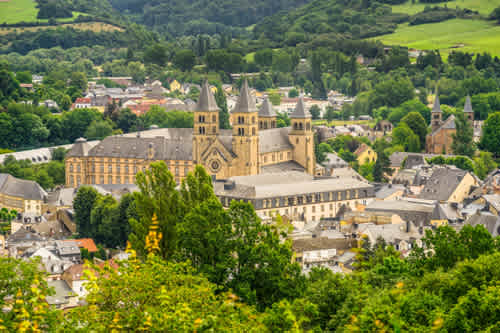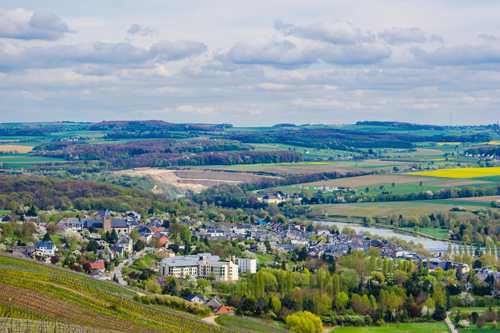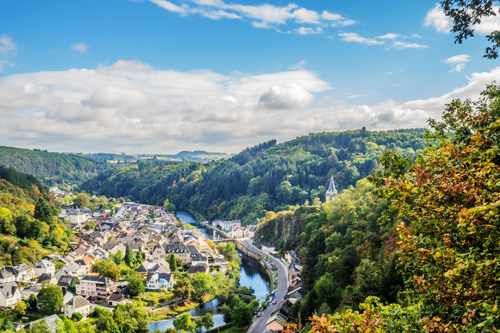Luxembourg offers a captivating journey through time, where the past and present gracefully mix and where history, architecture, and natural beauty meet for a delightful experience.
About Luxembourg
Nestled between France, Germany, and Belgium lies the Duchy of Luxembourg. Although it does not have a direct coastline, the Moselle River in its eastern region provides access to the Rhine River, facilitating travel by ship to Germany, the Netherlands, and the sea.
Despite its small size - just over 1000 square miles- Luxembourg's strategic location has made it an important country throughout history. Its past Dutch influence is evident in the official language spoken in the country, known as "Luxembourgish," a unique blend of German, French, and Dutch. Luxembourgish has been recognized as the official language in the Duchy since 1984, further highlighting the country's distinct cultural heritage.
Luxembourg, the capital city named after the Duchy, is a popular and delightful tourist destination. The city's strategic location, built atop a formidable cliff, has historically enabled it to defend itself against invading armies. Today, Luxembourg embodies a harmonious blend of modernity intertwined with captivating medieval architecture, and its well-preserved Old City has earned the prestigious title of a UNESCO World Heritage Site.
At the heart of the city stands the magnificent Grand Ducal Palace, a 16th century architectural gem. Since 1890, the palace has served as a venue for state functions, ceremonies, and official events. Parts of the palace are open to the public, offering guided tours that grant visitors a rare glimpse into its elegant architecture and rich historical significance.
Place d'Armes is one of the city's main squares, located in the heart of the historic center. Here, a delightful array of restaurants, cafes, and shops awaits, and locals gather to celebrate events and festivals, infusing the square with a lively and vibrant atmosphere.
Place Guillaume II, affectionately known as Knuedler, pays homage to Grand Duke Guillaume II with a striking statue of the Duke at its center. The 19th-century town hall graces the square, while two majestic bronze lion statues stand guard before it, adding a touch of regal splendor.
Place de la Constitution is located near the Duke Adolf Bridge, offering breathtaking views of the city and the winding Petrusse River that flows gracefully below. Here, the Gëlle Fra monument, affectionately known as The Golden Lady, stands tall, commemorating the valor and freedom of Luxembourg during times of resistance.
The Casemates du Bock, also known as Bock Casemates, comprise an extensive network of tunnels and burrows, stretching just over 14 miles and carved into the massive rock foundation on which the city is built. The construction of these fortifications began in the early 17th century and underwent expansion during the 18th and 19th centuries. Their primary purpose was to serve as a strong defense system for the city during times of military crises. The maze of tunnels provided the soldiers with shelter and protection, while storage warehouses held vital ammunition. The complex also accommodated service areas, feeding stations, medical facilities, artillery positions, and observation points that covered both near and distant ranges. Guided tours of the fortifications offers a glimpse into the military challenges the city once faced.
The Grund District is located below the old town, nestled beneath the towering cliffs of Luxembourg's Casemates du Bock. Characterized by its picturesque narrow streets, historic architecture, and the serene flow of the Alzette River, this charming district exudes a sense of timeless beauty and tranquility.
Here are several outstanding sites outside the city:
Vianden Castle is an awe-inspiring medieval fortress perched atop a commanding hill, offering a breathtaking view of the town of Vianden.
Bourscheid Castle, situated near the village of Bourscheid, is one of the largest castles in Luxembourg, dating back to the 10th century. Over the centuries, it was expanded and modified, and today it stands on a rocky cliff, providing visitors with captivating vistas of the Sûre River valley.
Beaufort Castle is nestled in the eastern part of Luxembourg amid stunning landscapes. Guided tours of the castle offer insights into its rich heritage and the captivating history of the surrounding region.
Larochette Castle is a medieval relic with picturesque ruins gracefully perched upon a rocky cliff, offering a magnificent view over the town of Larochette.
In the village of Useldange, the remarkable Useldange Castle is a blend of Romanesque and Gothic styles. Constructed in the 12th century, it served as a noble residence until the 18th century. Presently, the castle is open for organized tours, allowing visitors to step back in time and immerse themselves in its fascinating history.
Luxembourg's Ardennes, an extension of Belgium's Ardennes, offer lush green mountain landscapes perfect for indulging in nature activities such as hiking, camping, cycling, and fishing.
The Moselle River Valley meanders through the picturesque Luxembourg countryside, revealing breathtaking vineyards, charming villages, and inviting wineries.
Nestled around a bend in the River Sûre, Esch-sur-Sûre captures the essence of charm and tranquility that defines the Luxembourg countryside, making it an ideal destination to enjoy the country's natural beauty.
The Mullerthal region, often dubbed "Little Switzerland" or Petite Suisse Luxe Bourgeoisie, is renowned for its rocky landscapes, dense forests, and picturesque hiking trails, offering a paradise for nature enthusiasts.
Steeped in history, Echternach takes pride in being the oldest town in Luxembourg. Its focal point is the ancient Romanesque basilica, Willibrordusbasilika, constructed in the 11th century.
Luxembourg American Cemetery serves as the final resting place for 5,070 American soldiers who bravely fell during the battles of the area, including the Battle of the Bulge and the liberation of Luxembourg. The majority of these soldiers served in the US Third Army, led by the legendary General George S. Patton. In a testament to his humility and camaraderie with his troops, General Patton requested to be buried alongside his soldiers without a grand monument.
A visit to Luxembourg unveils a captivating journey through time, where the past gracefully intertwines with the present and where history, architecture, and natural beauty meet for an unforgettable experience.
Regions in Luxembourg
Attractions in Luxembourg
- Historic Center, Echternach
- Echternach Abbey
- Beaufort Castle, Echternach
- Historic Center, Remich
- St Martin Winecellars, Remich
- Bacchus Fountain, Remich
- Historic Center, Vianden
- Vianden Castle
- Indian Forest Adventure Park, Vianden
- Victor Hugo Museum, Vianden
- Trinitarian Church and Cloister, Vianden
- Museum of Caricatures and Cartoons, Vianden
- Historic Center, Luxembourg City
- Chemin de la Corniche, Luxembourg City
- Philharmonie Luxembourg, Luxembourg City








